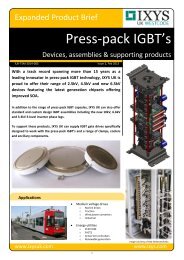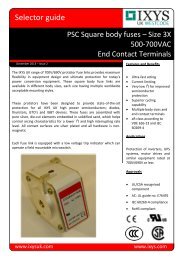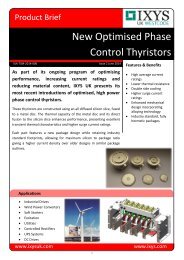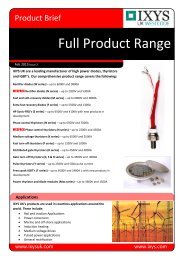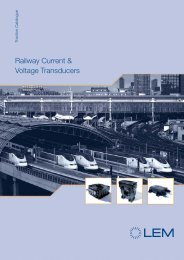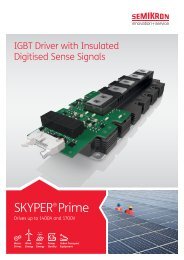isolated current voltage transducers
Create successful ePaper yourself
Turn your PDF publications into a flip-book with our unique Google optimized e-Paper software.
Fluxgate Technologies<br />
• Number of secondary turns is N S<br />
= 1000<br />
• I / V converter resistance (Fig. 34 - ref. 4) is R C<br />
= 100 Ω<br />
If the primary circuit impedance is Z P<br />
= 100 Ω, the induced<br />
primary <strong>current</strong> becomes:<br />
I Pind<br />
= V SW<br />
• N P<br />
/ (N S<br />
• Z P<br />
) = 6.8 • 10 / (1000 • 100) = 0.68 mA<br />
The <strong>voltage</strong> induced in the secondary by this parasitic<br />
<strong>current</strong> is:<br />
V Sind<br />
= I Pind<br />
• (N P<br />
/N S<br />
) • R C<br />
= 0.68 mA • (10/1000) • 100 = 0.68 mV<br />
For a primary <strong>current</strong> giving a 5 V output signal, the<br />
corresponding measurement error is 0.68 mV/5 V = 0.014 %.<br />
If, on the other hand, the primary impedance is small, for<br />
example Z P<br />
= 1 Ω the measurement error becomes much<br />
more significant, 1.4 % in this case.<br />
Example 3: CV <strong>voltage</strong> transducer – Accuracy<br />
calculation<br />
T A<br />
T A max<br />
+25 °C +70 °C<br />
Typical accuracy of the primary<br />
resistances 0.05 % 0.05 %<br />
Variation with temperature<br />
(typical coefficient 20 ppm/°C) - 0.10 %<br />
Typical resistance accuracy<br />
of the converter 0.05 % 0.05 %<br />
Variation with temperature<br />
(typical coefficient 20 ppm/°C) - 0.10 %<br />
Secondary offset <strong>voltage</strong>:<br />
- nominal is 5 mV 0.10 % -<br />
- Maximum with temperature<br />
is 10 mV - 0.20 %<br />
Maximum total error 0.20 % 0.5 %<br />
Example 4: Accuracy of the CV 1-1500 <strong>voltage</strong><br />
transducer (see datasheet)<br />
The CV 1-1500 <strong>voltage</strong> transducer is designed to measure a<br />
1500V peak <strong>voltage</strong>. According to the transducer datasheet,<br />
the output <strong>voltage</strong> will then be 10 V peak. Using this part<br />
within its operating temperature range of 25 to 70 °C the<br />
indicated accuracy is ±3. 0% including an initial offset of max<br />
±100 mV. This worst-case error is expressed as a<br />
percentage of the peak value.<br />
4.5 „IT-type“ Fluxgate <strong>transducers</strong><br />
LEM „IT-type“ closed loop Fluxgate <strong>transducers</strong> allow AC<br />
and DC <strong>current</strong> measurement with very high accuracy,<br />
linearity and stability, while eliminating the injection of noise<br />
into the primary.<br />
4.5.1 Construction and principle of operation<br />
The „IT-type“ transducer consists of a <strong>current</strong> measuring<br />
head made of three magnetic cores, C1, C2, and C3, with<br />
primary (w P1<br />
) and secondary (w S1<br />
to w S4<br />
) windings as shown<br />
in Fig. 35. Closed loop compensation is obtained by a<br />
secondary <strong>current</strong>, I C<br />
, fed into one of the secondary coils<br />
(w S2<br />
). The latter coil, magnetic coupled to the three magnetic<br />
cores, is connected in series with the measuring resistor to<br />
obtain an output <strong>voltage</strong> of typically 1 V with secondary<br />
<strong>current</strong>s of 200 or 400 mA.<br />
Compensation<br />
Amplifier<br />
V +<br />
+<br />
–-<br />
V –<br />
I c<br />
Low frequency<br />
correction<br />
High frequency<br />
correction<br />
W S1<br />
W S2<br />
C1<br />
I c<br />
Second<br />
Harmonic<br />
Detector<br />
φ µ<br />
P<br />
W S3<br />
W S2<br />
Figure 35: Principle of the IT transducer<br />
φ<br />
C2<br />
Iµ-<br />
Square wave<br />
generator<br />
Zero flux<br />
<strong>current</strong><br />
Iµ+<br />
P<br />
W S4<br />
W S2<br />
C3<br />
I P & w P1<br />
R m<br />
Output <strong>voltage</strong><br />
For the upper frequency range, the secondary <strong>current</strong> results<br />
from a transformer effect in two secondary coils (w S1 and w S2 ).<br />
For lower frequencies, including DC, the design functions as<br />
a closed loop Fluxgate transducer (§ 4.1), with the winding<br />
w S3<br />
and w S4<br />
being the Fluxgate sensing coils. These features<br />
are described in details hereunder.<br />
4.5.1.1 Transformer effect – high frequencies<br />
The <strong>current</strong> transformer is made with a primary (w P1<br />
) and two<br />
secondary coils (w S1<br />
and w S2<br />
), wound around the same<br />
magnetic core (C1). The secondary coils are connected to a<br />
compensation amplifier in order to improve the overall<br />
performances. This system works as follow:<br />
• The coils w P1<br />
and w S2<br />
work as a classical <strong>current</strong><br />
transformer, where a <strong>current</strong> I C<br />
is induced into the<br />
secondary coil, proportional to the primary <strong>current</strong> to be<br />
measured, leading theoretically to a zero total flux into the<br />
magnetic core.<br />
• In practice, a residual flux remains, reflecting the imperfect<br />
coupling between the primary (w P1<br />
) and secondary (w S2<br />
)<br />
coils as well as the transformer burden. For a <strong>current</strong><br />
transformer, this residual flux is an image of the<br />
measurement imperfections.<br />
• The coil w S1<br />
, connected on a high impedance, collects a<br />
non zero <strong>voltage</strong> when an AC residual flux occurs: a signal<br />
is then sent into the correction amplifier, adjusting the<br />
secondary <strong>current</strong> I S<br />
until the total flux is equal to zero.<br />
The resulting <strong>current</strong> transformer performances are<br />
remarkable.<br />
φ<br />
φ µ<br />
31





